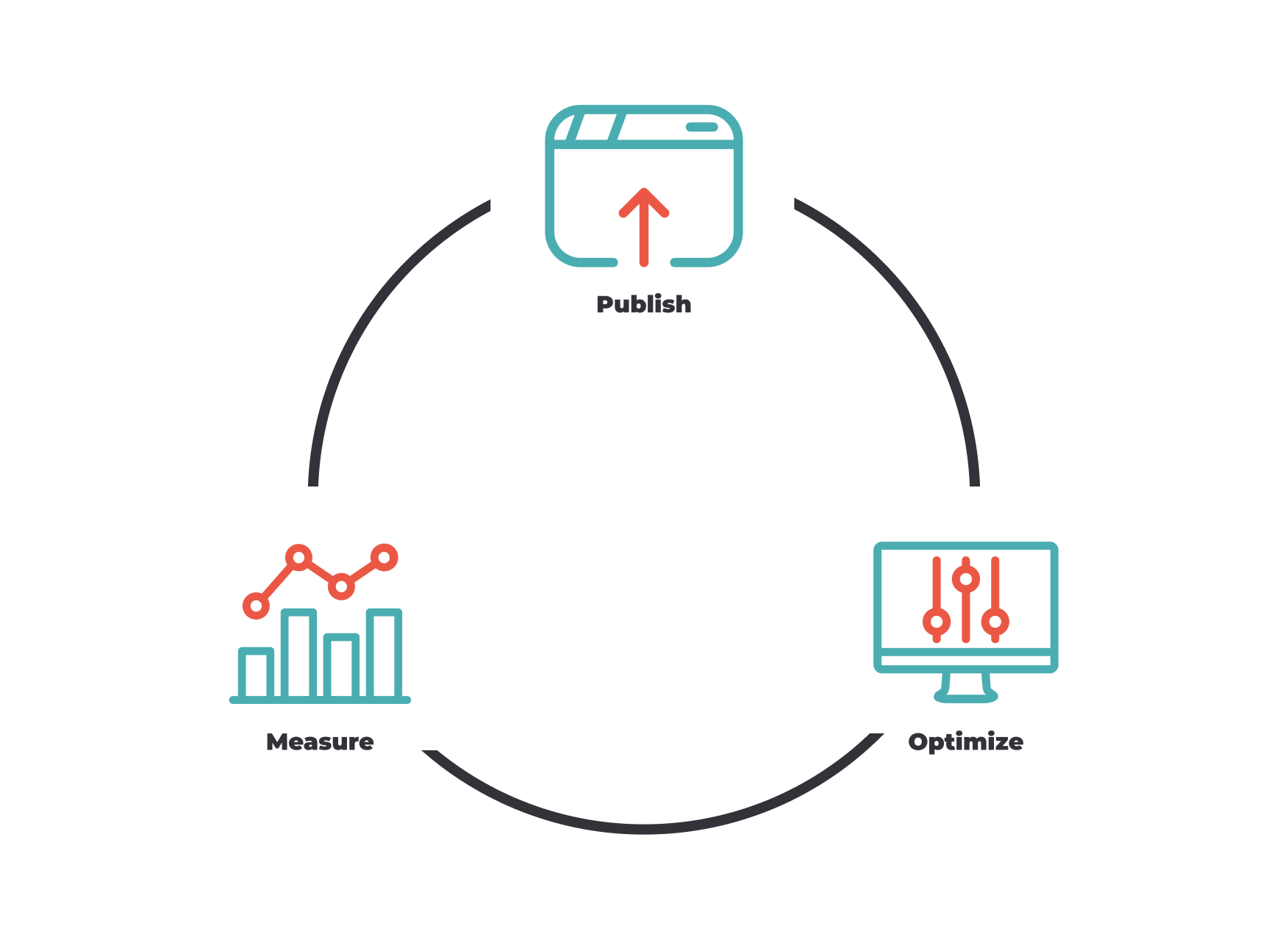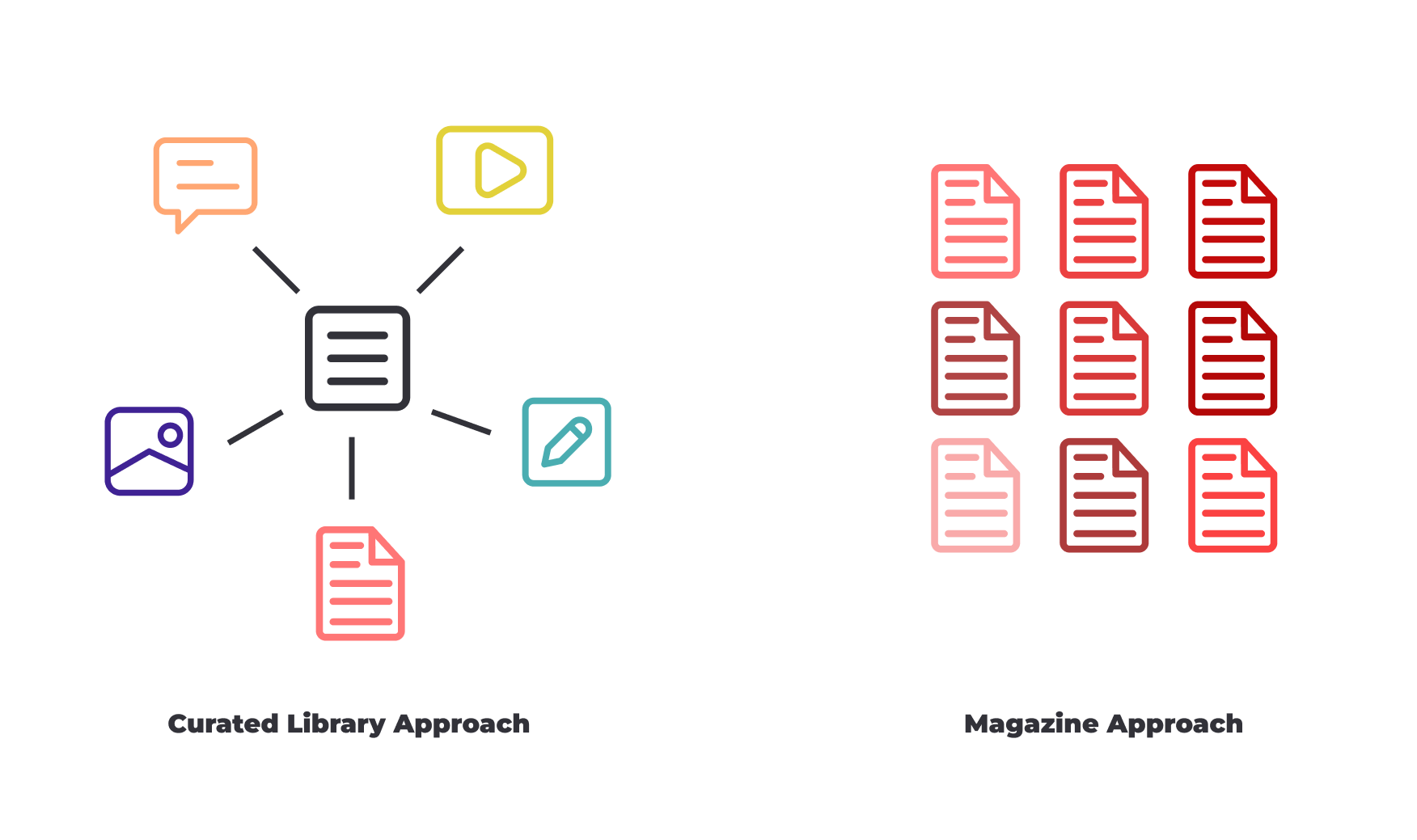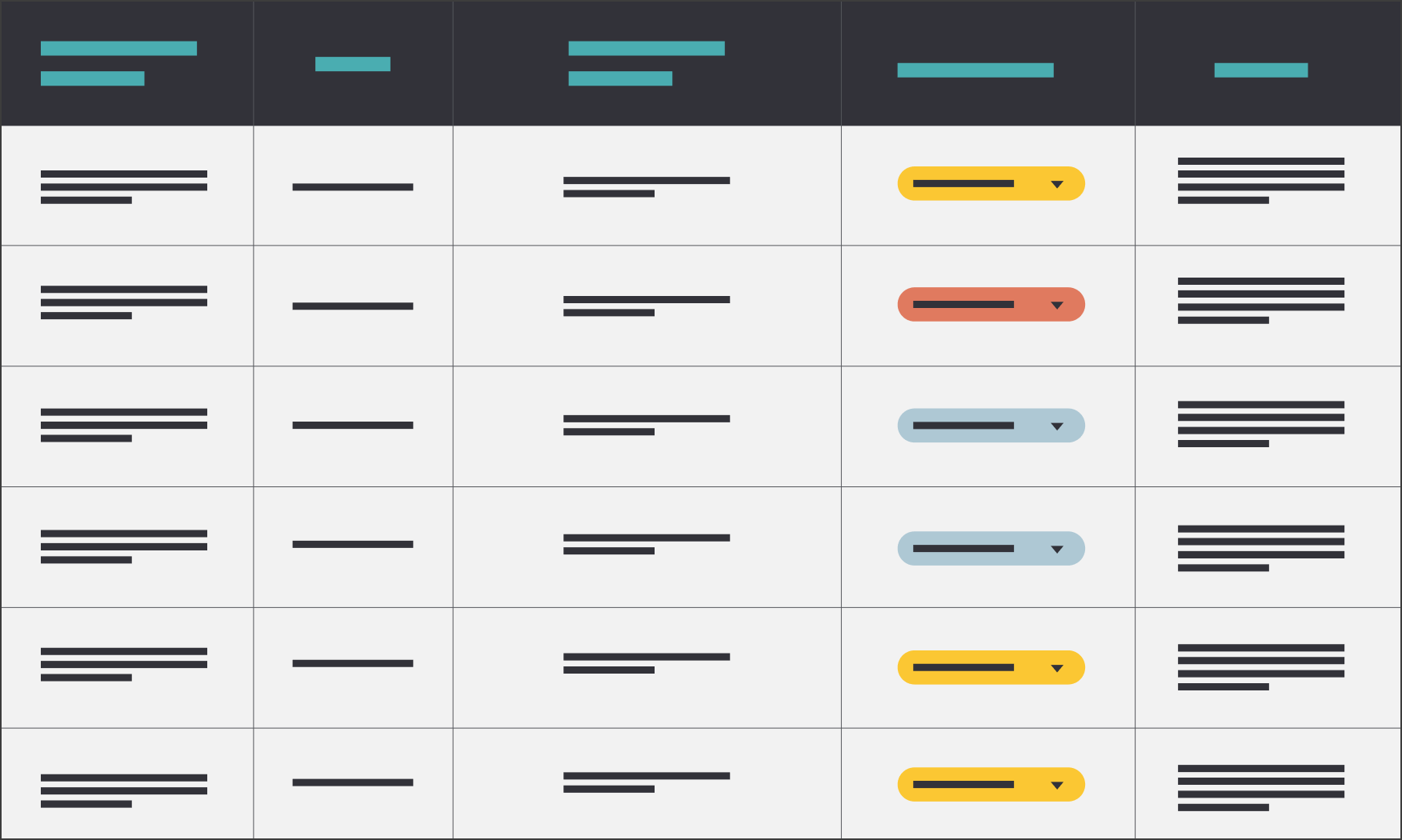Exiting the SEO Content Hamster Wheel
When do we get to stop producing new content?
For years, the standard SEO response was: Never. You’re on this content creation hamster wheel until your website breaks or you go out of business, whichever comes first.
But after years of following that playbook, we knew there had to be a better way.
Enter Progressive Optimization.
What Is Progressive Optimization?
The traditional way to do SEO is to conduct keyword research, publish optimized content to your website, and then rinse and repeat. Progressive SEO is here to disrupt that cycle.
It doesn’t mean we stop producing new content completely. It does mean that we don’t abandon our pieces as soon as they’re published — instead, we measure, refine, and optimize over and over until the content we created is performing as well as it can. Then, we invest any additional time into the creation of new, carefully planned content.
The concept is built on this simple principle: The more you optimize for robots, the less you optimize for a user. Sure, you need to take steps to appease the search engines and their algorithms, but you shouldn’t let that distract from your primary goal of connecting with and serving the user.
When you launch content, you should strike a healthy balance between the two. Then, as you gather performance data, you can see where the content may be over- or under-performing, make subtle (or not-so-subtle) tweaks to the content, republish, and keep measuring.

The SEO Shelf Life
Google’s algorithm is fickle. Because of that, almost every piece of content has a shelf life. If it’s ranking well in search today and driving tons of traffic, that isn’t a guarantee of the same performance tomorrow.
This reality is baked into the approach of Progressive SEO. Optimization is never done. It’s constantly being measured and refined over time. That way, your content isn’t desperately hoping to stay in Google’s good graces — it’s attuned to the algorithm’s changes. It listens and responds, and continues to rank highly as a result.
The key to effective Progressive SEO is taking a curated library approach to your content instead of a magazine approach.

A magazine approach:
- Covers and re-covers the same old topics in slightly different ways
- Obsesses over attracting the next fresh set of eyeballs
- Overreacts to tiny changes in user intent and demand
- Generates clicks
A curated library approach:
- Covers topics with original, expert-led perspectives
- Obsesses over providing value to the user
- Taps into enduring streams of user intent and demand
- Generates connection
Instead of rehashing things that have been said a million times over, we’re building content under intentional categories, defining the breadth of each category in advance, and then producing content based on that roadmap.
Yes, we’ll revisit categories and topics. Yes, we’ll make room for topical newsworthy commentary. But we’ll do it all within a carefully defined library structure so that each piece has a job and is built to accomplish that job.
Once you’ve established that library, users will be able to discover, consume, and explore your content repository in the way that’s best for them. In other words, your content can adapt to every stage of the customer journey with precision, because you created it with intention.
The Core Principles of Progressive Optimization
The concept of Progressive Optimization sounds easy, right? In reality, the execution of it within a content team can be complex. Let’s break down the principles that guide successful implementation.
Intentional Content Production
We’ve touched on this already, but it bears repeating: In this model, each piece of content that exists in your content repository is carefully defined, crafted, organized, and linked to for a specific purpose. We’ve done deep audience and keyword research to build a roadmap for content that works cohesively as a whole. No pages exist simply because “we had to generate 4 posts that month.”
Each piece gets its own dedicated strategic direction — what we call a Content Optimization Guide — which is essentially a standard content brief on steroids. (More on this in a minute.) This guide ensures that, from ideation to end-to-end execution, each piece of content is intentionally built to support the initial purpose.
Refined Listening and Measurement
If you thought you were done after hitting the publish button, think again.
For Progressive Optimization to work, you need a defined system of measurement that allows you to regularly collect the right data points for each piece to understand how it’s performing against its potential. At Magneti, we establish this potential when we create the Content Optimization Guide, by using competitive benchmarking to gauge traffic potential and hone target keywords.
Then, we set recurring tasks in our project management system that remind us to revisit the content piece every 90-180 days to ensure that it’s performing as expected and allow us to spot any opportunities for optimization, UX improvement, or quality enhancement. If the regular content audit process shows that our piece is underperforming, we move to the next step in Progressive Optimization.
Technical Content Optimization
In this step, we get granular. We zoom in on performance and start pulling all the small levers that impact a page’s ability to rank well in search engines.
This level of detail isn’t totally necessary for initial production, but after we’ve observed the performance of a piece in the wild, it’s an important ranking-boosting step. This process revolves around a proprietary tool we developed called a Micro-Optimization Guide. In it, we divide our analysis into 5 key segments:
- Power Factors: These are your classic, high-impact, on-page SEO factors that we know make a massive difference. Often, in our initial optimization of a piece, we use a light hand here to preserve an excellent user experience. In this step, we gradually become more heavy-handed with our SEO tactics, updating things like Title Tag copy, H1 tags, overall word count, intro copy and top-of-fold experience, and more.
- Intent and UX Factors: These include many elements that both we and Google believe translate to a positive experience for a website visitor. Because they’re good for users, Google tends to reward websites that score positively in these areas, which include things like content relevance and utility, PageSpeed performance, mobile friendliness, page layout, and overall readability across device types.
- Internal Linking Factors: This focuses more on “PageRank” factors in Google, where the core concept is that Google interprets the importance and ranking ability of a page based on how extensively it is interlinked with your entire website. Basically, a page that is linked from your homepage, your main menu navigation, and your footer has a better chance of ranking well than a page that is only accessible via your XML or HTML Sitemap. Here, we’ll zoom out and look at the overall architecture of your website and see how each particular page fits into the crawl map, and then we’ll zoom in and look at the individual links from each internal page, identifying opportunities to improve in the minds of search engines and users.
- Schema Factors: This is a focused category that balances the page type against the available Schema structured data markup options and highlights any areas where key content elements on that page could be better marked up to improve search engine crawlability, understanding, and rankability in various SERP features.
- Content Factors: Here, we focus on the content itself. Is it logically structured and comprehensive? Is it mapped to proper HTML heading tags? Does it use the right keywords in the right ways? For example, if you have a post about Content Optimization, you’re most likely going to want to have words and phrases like “SEO,” “search engines,” “keywords,” and “Google” in it. When we first write a page, we focus primarily on quality and reader-friendliness. But as we move through the Progressive Optimization process, we look for opportunities to work in specific words and phrases in a natural way to strengthen the page’s topical coverage and its ability to rank based on Google’s interpretation of our coverage of the topic and its ability to bring value to users.
The Key Assets
Now that we’ve hinted at a bunch of Magneti SEO tools, let’s break them down and explore their role in the process.

Content Inventory
The Content Inventory is a documented inventory of every page on the website. It maps key characteristics of each page, for example:
- URL
- Title
- Page type
- Page category
- Etc.
It also maps benchmarks and metrics that we use to measure performance:
- Google Search Console clicks and impressions
- Target keyword
- Keyword ranking
- Optimization score
- Etc.
To keep track of our analysis, completed work, and next steps, we have a “status,” “last updated,” and “notes” section that integrates into our project management system, keeping us all on the same page for each month’s scope of work. Everything ties back to the Content Inventory, and if it’s not documented in there, it likely doesn’t exist.
Content Roadmap
The Content Roadmap is a documented breakdown of the categories, subcategories, and individual topics for our content library.
After we’ve cleaned up existing content and strengthened the existing website content, we move into new content production to build out the rest of our content library. The roadmap defines the structure and topical hierarchy of what we’re creating and where it lives on the site. To keep our content clean, relevant, and compelling, 99% of our production is guided by this precisely curated roadmap.
Content Optimization Guide
Another crucial element of our content system is the Content Optimization Guide, which dictates the focused strategy of a piece of content. In it, we combine keyword research, competitor content analysis, a content brief, and an SME interview guide all into one hard-hitting strategic asset.
This document is the source of truth for each piece of content and is designed to give our writers everything they need to produce the best piece possible, in terms of both user experience and overall strategic alignment.
As a bonus, this guide supports content audits by providing all the contextual information we need to perform effective analysis.
Micro-Optimization Guide
As detailed in the bullet points above, the Micro-Optimization Guide is the key piece of the Progressive Optimization process. Developed using 15+ years of deep SEO and content marketing experience, it provides a standardized approach to auditing a single piece of content and communicating key recommendations to other internal SEO and content marketing stakeholders.
The Future of SEO: Content With Purpose
There’s a lot of talk about AI killing SEO and how the future of SEO is optimizing for LLMs and RAG (enough buzzword acronym soup for ya?), but the fact of the matter is, we’re not there yet. And it might be a while before we get there.
For now and the foreseeable future, people with clear intent (I need information, I need a product, I need a service) are going to search engines like Google and performing a search to meet their needs. They want valuable content, and Google wants to give it to them.
Creating a piece, optimizing it for some keywords, publishing it on your site, and moving on might result in a spike of traffic, but it’ll fizzle out as quickly as it arose. And that just isn’t going to cut it in 2024.
Progressive Optimization is the key to creating content with purpose, which gives it the best chance of performing well in organic search and presents the best possible entryway into your website for your target audience.
After all, if your content is value-rich and relevant, your customers won’t bounce from your site after ten seconds — they’ll be hungry for more.
Want to talk SEO? Let us know.